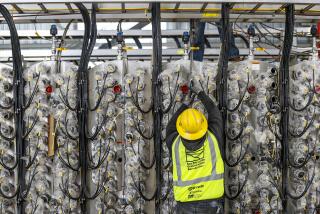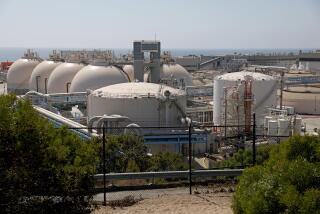Navy, State Sign Pact to Clean Up Contamination at Seal Beach Base : Environment: The agreement, reached after two years of negotiations, is the first between the Navy and a state.
SEAL BEACH — The U.S. Navy has signed a long-awaited agreement with state environmental officials to investigate and clean up toxic waste contamination at the Seal Beach Naval Weapons Station, officials announced Thursday.
The pact means that the Navy will be responsible for a major, lengthy project to identify the extent of chemical pollution at the 5,000-acre base and then clean it up.
State environmental officials believe that at least 26 areas at the base are tainted with a variety of dangerous chemicals--from battery acid to lead--that were dumped there for several decades.
Some toxic metals have seeped into ground water, and oily waste may be responsible for minor harm to animal habitat at the large national wildlife refuge located on the base.
“This is a major investigation, and there’s a lot of work to be done. We’re looking at hazardous materials that have resulted from 30 years of operations at the base, from the mid-1940s until the mid-1970s, when a lot of these practices finally stopped,” said Allan Hirsch, a spokesman for the toxics control division of the California Environmental Protection Agency.
The Navy’s plan outlining details of the investigation must be completed by Oct. 30, 1992, while a cleanup proposal must be drafted by June, 1995. Overseeing the project will be the California EPA and the state’s regional water-quality agency.
“The federal government, in this case the U.S. Navy, is being very upfront about what was done here and what we’re doing to clean it up,” said Richard Williamson, spokesman for the Seal Beach Naval Weapons Station. “While it was permitted under past practices, we’ve all grown smarter about sensitivity to our environment. We want to restore the environment here to its natural state as much as we can.”
State officials said they were especially pleased by the environmental agreement, which came after two years of negotiations, because it is the first between the Navy and a state.
James Strock, secretary of the California Environmental Protection Agency, said the agency intends for the Seal Beach agreement to “become a model for future cleanup efforts at other Navy and Marine Corps facilities in California.”
“This is a groundbreaking, pioneering agreement,” Hirsch said. “It’s the first time in the entire country that the Navy has agreed to hand over oversight for this type of work to a state agency.”
The Navy has negotiated similar cleanup deals with federal officials. But this agreement means that the Seal Beach base will be cleaned up without the involvement of the federal Superfund program, which often is bogged down in bureaucratic delays.
Four areas at the base are suspected of being especially worrisome, including a disposal pit where cadmium and chromium have seeped into ground water, according to a Navy report. The four sites contain materials from sandblasting, welding, metal cleaning, painting, vehicle repair, oil drilling, missile work and other activities.
At one site, some wetland vegetation has died, according to the Navy’s 1985 report. The cause is unknown, but oil wells operate on an island in the wetlands, and toxic wastes associated with the drilling were dumped there from 1954 until the 1970s. The wetlands are used by five endangered birds and hundreds of other types of waterfowl.
Federal wildlife officials say birds in the wetlands seem to be unaffected. Crabs and other organisms eaten by light-footed clapper rails, an extremely rare and endangered bird, have been tested there, but no chemicals have been detected, said Dick Zembal, a Fish and Wildlife Service biologist who monitors the Seal Beach refuge.
“There’s always a chance of the contamination getting into the marsh, but it isn’t there as far as we know,” Zembal said. He said the way water moves though the area, including large amounts of ocean flushing, seems to safeguard the wetlands.
Also, at a 22-acre landfill on the base, drums of chemicals such as paint and cleaning solvents were deposited from the mid-1950s until 1973. The soil there is contaminated with carcinogenic liquids and metals such as methylene chloride, mercury and lead.
Determining how much soil and ground water has been tainted will be one of the Navy’s first jobs. State officials said that there is no immediate health threat but that they worry about chemicals spreading farther into the ground water.
The Navy first detected chemicals in the soil in 1985, but it was not until about 1989 that the Pentagon directed local bases throughout the nation to cooperate with local and state efforts to clean up waste. Since then, the Navy and state officials have been negotiating terms of the agreement.
Williamson said the Navy has reviewed its records and interviewed past and current employees in Seal Beach to determine areas where waste was spilled or dumped. “What that did for us is give us ideas of places to go look. Next, an engineering firm will go out and see if there’s evidence (of contamination) out there,” Williamson said.
In addition to paying for the investigation and cleanup, the Navy agreed to reimburse the state agencies for oversight expenses.
Cost of the project has not been estimated, but similar investigations and cleanups routinely cost millions of dollars. A special national Defense Department fund was created by Congress to fund toxic cleanup work at military bases.
A similar agreement was reached last year between the federal Environmental Protection Agency and the Defense Department to clean up waste at the El Toro Marine Corps Air Station, which is a national Superfund site.
More to Read
Sign up for Essential California
The most important California stories and recommendations in your inbox every morning.
You may occasionally receive promotional content from the Los Angeles Times.










